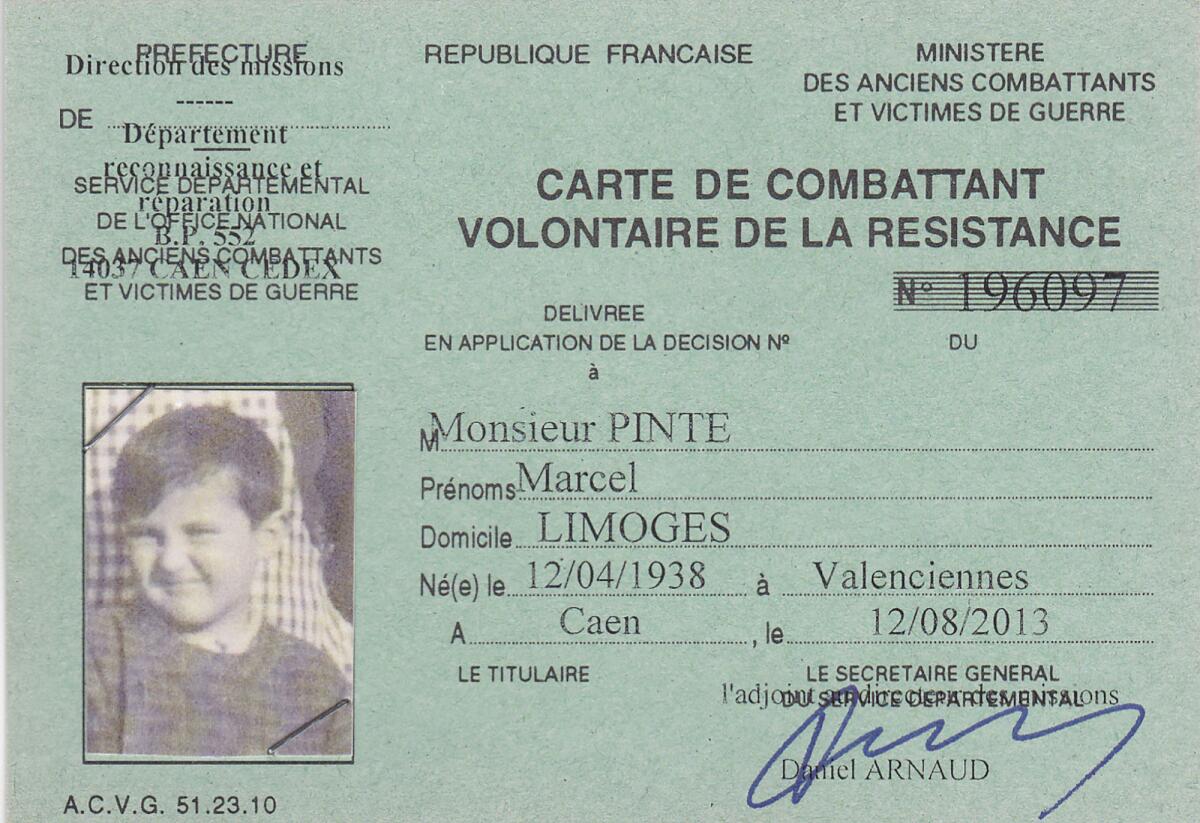He was a 6-year-old French Resistance agent. Now he’s finally being honored

- Share via
PARIS — Quinquin, his code name, followed orders, crossing enemy lines to pass messages if needed. In the end, he was killed by friendly fire at the age of 6, probably France’s youngest member of the Resistance fighting the occupying Nazis during World War II.
Marcel Pinte has only recently been getting his due. Just last week his name was inscribed on a monument to the war dead in Aixe-sur-Vienne, a town of fewer than 6,000 people in central France, near his zone of operation. He was among the fallen being honored Wednesday, when France commemorates the Nov. 11, 1918, armistice that ended World War I and pays homage to all those who have died for the nation.
The little boy lived at the heart of the “army of the shadows,” as Resistance fighters were known, led from London by Gen. Charles de Gaulle. On the ground, Marcel was run by his father, Eugene Pinte, a local Resistance chief who set up an operations center at a farm outside Aixe-sur-Vienne. His farmhouse received coded messages from London and parachute drops of supplies in a field nearby.
Four years ago, a street was named after Eugene Pinte, whose code name was Athos and who led the liberation of the town.
Marcel, the youngest of five children, was put to work helping fighters with an array of tasks. He could, for instance, slip away to nearby farms to pass messages, according to accounts published by a relative, Alexandre Bremaud.
Nicknamed Quinquin by Resistance fighters, from a children’s song in northern France, where he was born, Marcel served as a liaison agent, but he was still a child.
“There was a bit of carefreeness because of his age. A resident told his father to be careful because Marcel sometimes sang songs learned from fighters,” the newspaper Le Figaro quoted Bremaud as saying.
But songs weren’t what would take his life. A sensitive Sten automatic pistol dropped by parachute with other arms and munitions let off a spray of gunfire when the weapons were being distributed Aug. 19, 1944.
Marcel was hit and died.
The day before, his father had led a rout of enemy troops converging on Aixe-sur-Vienne. “Very touched by the disappearance of his son ... the commander did not change plans and continued encircling [nearby] Limoges with his troops,” said a speech delivered by Bremaud and another family relative, Marc Pinte, for the inauguration in 2016 of the street named after Eugene Pinte.
Top Resistance commanders attended Marcel’s funeral on the morning of Aug. 21, 1944. His father helped liberate Limoges that evening.
Several days after Marcel’s death, containers descended on the field in a final drop, but the parachutes were black.
“The British knew that the little Marcel played a real role. This parachute was the calling card sent to the family,” said Marc Pinte, who gave the newspaper Le Monde a guided tour of the area.
An official card for “volunteer combatants of the Resistance” was delivered Aug. 12, 2013, in the name of “Monsieur Marcel Pinte” by the National Office of Former Combatants and War Victims.
More to Read
Sign up for Essential California
The most important California stories and recommendations in your inbox every morning.
You may occasionally receive promotional content from the Los Angeles Times.









